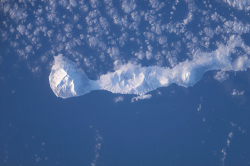While Earth’s northern hemisphere welcomes the new year with the quiet chill of winter, Mars transforms into a fiery theater of natural phenomena as it enters spring. The Red Planet completed its latest orbit around the Sun on November 12, 2024, marking the start of a new Martian year. Unlike Earth, where spring signals a gradual thaw and gentle growth, Mars experiences explosive changes that reshape its alien landscapes.
From avalanches of frozen carbon dioxide to geysers erupting in violent plumes, these phenomena are a striking contrast to the serene seasonal transitions we know. Powered by Mars’ thin atmosphere and dynamic climate, the thawing of icy deposits releases bursts of energy that propel the surface into chaotic transformation. NASA’s Mars Reconnaissance Orbiter (MRO) has been observing these seasonal shifts for nearly two decades, revealing a world where spring arrives with a bang—literally.
Avalanches That Redefine Spring
One of the most dramatic features of Martian spring is the frequent occurrence of avalanches. Unlike Earth, where avalanches involve snow and rock, Mars’ slides are dominated by frozen carbon dioxide—dry ice. As temperatures rise, the dry ice sublimates, transitioning directly from solid to gas, triggering massive movements of material down cliffs and slopes.
In 2015, NASA’s HiRISE (High-Resolution Imaging Science Experiment) camera captured a jaw-dropping image of a 66-foot-wide chunk of carbon dioxide frost in freefall, cascading from a towering cliff. “We’re lucky we’ve had a spacecraft like MRO observing Mars for as long as it has,” said Serina Diniega, a planetary surface researcher at NASA’s Jet Propulsion Laboratory (JPL). “Watching for almost 20 years has let us catch dramatic moments like these avalanches.”
These avalanches are not just visually spectacular—they also provide scientists with valuable insights into the Red Planet’s surface dynamics. Each event reveals how Mars’ thin atmosphere interacts with its icy deposits, reshaping the landscape with every spring thaw.


Explosive Geysers and Martian Spiders
Spring on Mars also heralds the eruption of gas geysers, a phenomenon unique to the planet. As sunlight penetrates translucent layers of frozen carbon dioxide, the ice sublimates from the bottom up, creating trapped pockets of gas. When the pressure becomes too great, these pockets explode, sending plumes of gas, sand, and dust high into the atmosphere.
“You get lots of cracks and explosions instead of melting,” explained Diniega. “I imagine it gets really noisy.” These geysers leave behind dark fan-shaped patterns on the surface, marking where the debris settled.
In the southern hemisphere, these explosive events carve intricate, spider-like marks called “araneiforms” into the Martian soil. These formations are created as the erupting gas scours branching channels into the ground, leaving behind patterns that resemble the legs of enormous spiders. To better understand this process, researchers at JPL have recreated it in laboratory conditions, shedding light on how these alien features form and evolve.


Polar Winds and Swirling Troughs
The Texas-sized ice cap at Mars’ north pole is another focal point of springtime transformation. Here, powerful winds carve spiral troughs into the ice, creating swirling patterns that reveal traces of the red soil beneath. “These things are enormous,” said Isaac Smith, a planetary scientist at Toronto’s York University. “You can find similar troughs in Antarctica, but nothing at this scale.”
As temperatures rise, the winds accelerate through the polar troughs, a process known as adiabatic warming, which also drives phenomena like Santa Ana winds in California. These gusts shape the ice cap over millennia, creating the iconic swirls that are visible from orbit.


Migrating Dunes: Mars in Motion
Spring winds also set Mars’ sand dunes in motion. During the cold Martian winter, frozen carbon dioxide locks these dunes in place. But as spring arrives and the ice sublimates, the winds resume their work, shifting the sand across the surface. Over time, this slow migration reshapes the planet’s landscapes, just as similar processes occur on Earth.
Recent studies revealed that carbon dioxide frost forms a thin layer over polar sand dunes during winter. This frost thaws away in spring, freeing the dunes to begin their slow, steady journey once more. These observations are helping scientists understand how Mars’ dynamic surface evolves over time and what role seasonal changes play in shaping its unique geology.


A Planet in Flux
Every Martian spring offers a slightly different spectacle. Variations in temperature and sublimation rates control the intensity and pace of these explosive transformations. “Springtime on Earth has lots of trickling as water ice gradually melts. But on Mars, everything happens with a bang,” Diniega noted.
The nearly two decades of observations from the MRO have been pivotal in capturing these phenomena. Equipped with cutting-edge instruments like HiRISE, the orbiter continues to provide breathtaking views and critical data, allowing scientists to unravel Mars’ secrets one year at a time.
A New Chapter in Exploration
Mars’ dramatic seasonal transformations highlight the planet’s volatile nature and its potential for harboring insights into planetary evolution. From avalanches and geysers to wandering dunes and polar winds, these phenomena are more than just curiosities—they are keys to understanding Mars’ history and its capacity to support life.
As scientists prepare for future missions, the data gathered by the MRO and other instruments will shape our approach to exploring and perhaps even colonizing the Red Planet. With every spring, Mars reminds us of its restless, ever-changing spirit—a world where even the thawing of ice becomes a cosmic spectacle.
Got a reaction? Share your thoughts in the comments
Enjoyed this article? Subscribe to our free newsletter for engaging stories, exclusive content, and the latest news.









Leave a Comment